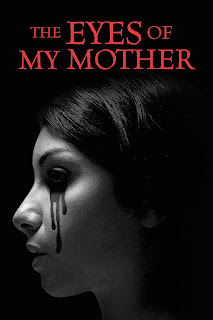The Eyes of My Mother, written and directed by Nicolas Pesce, contains few of these elements. It's shot in black and white, but instead of hiding a lurking killer, the shadows hide the rest of the world, and the light shows us what we'd rather not see. Violent, awful things happen to people, but for the most part, we don't see these actions, just the perverse aftermath.
Almost nothing is shown, and even less is explained, but The Eyes of My Mother proves to a startlingly effective horror movie. More character study than thriller, it offers a disturbing take on loneliness.
The setup could have been the basis for a sequel to The Texas Chain Saw Massacre: people keep stumbling upon this house in the middle of nowhere and become trapped by the lunatic living there. That lunatic is Francisca (Kika Magalhaes), a pretty young woman raised in the house by her parents.
But The Eyes of My Mother is not a standard horror movie. Instead of taking place over one night, it takes place over years. We see Francisca as a child, we meet her parents, and we see how their rearing shaped her. The movie is told from her perspective, and her victims are merely parts of little episodes that occur along the way.
Pesce’s favorite image is a long, wide shot through a window. We see many things through the looking glass, so to speak: a lone figure on an empty stretch of highway (through the windshield of a truck), the family barn (from the upstairs bedroom), and more.
This creates an alienating, almost unworldly effect. There are no supernatural elements in the movie, but at times, it feels like we're observing another world. Normal humans look small and helpless, overwhelmed by their stark surrounding. We are miles away from anything resembling normal civilization, so no help will arrive.
When folks try to escape, the unbroken takes tell us they won't get far. Seeing them through the kitchen window only keeps them bound to the house, visually as well as literally trapped. We watch knowing the inevitable will happen, and Pesce does not rush either his camera or his narrative. He lets things unfold quietly.
We see the morbid strangeness through what Pesce shows and doesn't show. We don't see the murders or the attacks, but we see the little girl cleaning up the blood in the bathroom while her father sits and smokes in front of the TV. Insanity is depicted as attempted normalcy in the face of appalling circumstances. Francisca doesn't want to be alone, and her efforts at companionship drive the story.
There's mostly only ambient background noise, but occasionally, we hear music. It reminded me of Blade Runner's soundtrack, droning, electronic, unsettling. Like the movie as a whole, it is hypnotic and surreal.




No comments:
Post a Comment